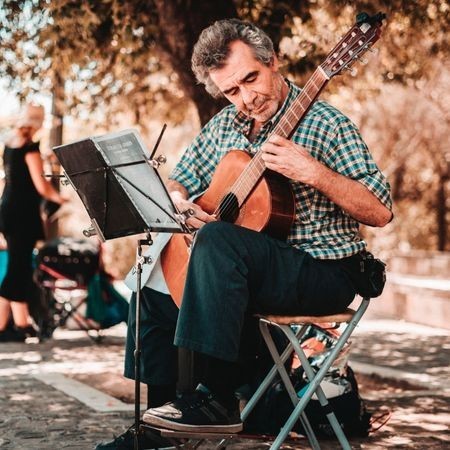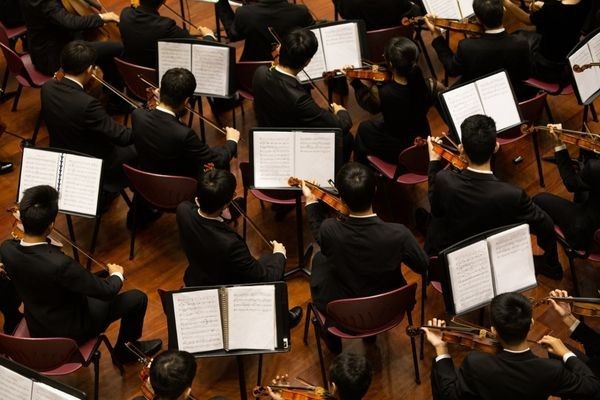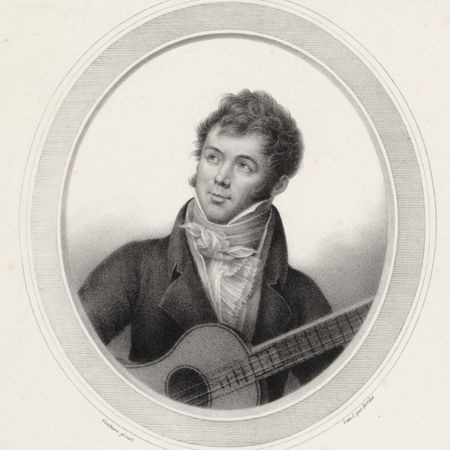4 Reasons To Learn
Classical Guitar

Compared to the wider world of guitar playing, classical guitarists make up a fairly small group. That said, it’s also true that there are more classical guitarists than ever, as well as many competitions, concerts, and festivals that serve the community. So it’s basically a small world that feels bigger once you’re in it. And I think interest in classical guitar will only grow in time.
This post is all about why, if you play guitar, you should consider learning classical. I’m convinced that everyone has something to gain from at least dipping their toes into concert music. If nothing else, learning some classical technique will help you in your own guitar style. Plus, who doesn’t like at least some kind of classical music?
2) Classical Technique

Don’t really care for classical music? Surprisingly, you might still want to learn some classical guitar. This is because a classical guitar education will greatly enhance your technique.
Fingerstyle guitar is becoming increasingly popular these days, and classical guitarists have developed a systematic and intelligent approach to learning to play with their fingers. You simply won’t find a greater wealth of information for training up your right hand.
Classical guitar technique is all about striking a balance between tension and
relaxation. Many teachers claim that the root of virtuosity is the ability to play as effortlessly as possible. You also want to keep all of your joints in the middle of their range of motion most of the time. This allows you to move rapidly and powerfully while preventing injuries.
A Technical gold mine
I didn’t pick up classical guitar until I was two years into learning fingerstyle. My technique was poor and I lacked guidance on how to improve it. Discovering classical guitar was like a technical and methodical gold mine. I found countless books explaining good technique and answering all the detailed questions I had.
Part of the purpose of this post is to help others discover the usefulness of classical guitar. Again, even if you don’t see yourself playing classical music, you should definitely explore the incredible pedagogical resources of this neglected guitar style. I’ll recommend two books right out of the gate, and you can find more on my recommendations page.
For developing fingerstyle technique, check out Pumping Nylon by Scott Tenant. If you’re looking for a more advanced technical workbook, you can’t do better than Kitharologus: The Path to Virtuosity by Ricardo Iznaola. For learning how to practice better, I suggest The Natural Classical Guitar by Lee Ryan and On Practicing by Ricardo Iznaola. (Yes, I’m a big Ricardo Iznaola fan).
For some great online information on classical technique, you’d do well to check out This is Classical Guitar. It’s one of the best websites offering free resources (including sheet music, method books, and video lessons) for classical guitarists.
I’ll also note that you don’t have to adopt a classical guitarist’s sitting position to develop classical technique. It’s really more about how you position your wrists, hands, and fingers than whether you use a footstool.
4) Fingerstyle Mastery

Fingerstyle is part and parcel with the classical tradition. All classical guitar players pluck the strings with their fingers (or nails, or a combination of both). Given that fingerstyle is becoming popular with steel-string players, it makes sense for them to look to the most established fingerstyle tradition for guidance.
Classical guitar definitely made a big difference for my own right-hand technique. I didn’t really understand the best way to pluck the strings until I read some books on classical guitar.
You might think that plucking strings with your fingers is easy and that anyone could do it. That’s true in a way, of course. We can all pluck a guitar string well enough to make sounds. However, I can’t emphasize enough the difference between a strong pluck and a weak one.
We can compare finger-strokes to tennis strokes in this regard. I can hit a backhand; Rafael Nadal can hit a backhand. No one would deny that we can both hit that stroke. Yet any reasonable onlooker, watching our backhands in turn, would see the world of difference between my stroke and Nadal’s. It’d be like comparing a needle to a sword.
And so it is with finger-strokes for guitarists. Our fingers can strike the strings with tremendous power and precision. But in order to do that, they require sustained, intelligent training. I strongly suggest you go to classical guitarists for that training. As I said before, you don’t need to play classical music to benefit from classical technique. Simply learn the strokes and take them where you will.
Conclusion
I hope I’ve convinced a few of you to explore classical guitar. In fact, I suggest you explore basically every style of guitar you can. We can all learn from each other, and there’s a lot of great information out there.
Fingerstyle players in particular stand to benefit from classical instruction. If you’re like me, you’ll find that classical guitar “unlocks” you right hand. I’ve also found that many of the great fingerstyle players out there have had at least some exposure to classical guitar (or some other classical instrument).
If you’re starting to get interested in classical guitar, definitely check out my recommendations page for a list of amazing books on the subject. All told, I hope you find what you’re looking for!
1) Classical Music

The ultimate reason to learn classical guitar is to give yourself the best opportunity to play classical music. If you like Beethoven, Bach, and Brahms (to name a classic trio), then you ought to join the musicians committed to play their compositions as well as possible.
Guitar, though ubiquitous in popular styles of music, only makes up a very small share of the classical world. Indeed, classical guitarists are a rare phenomenon. The repertoire for guitar is barely known to the general public, and many guitar players seem unaware that classical guitarists even exist.
And yet, if you’re a guitar player who wants to play classical music, then classical guitar is the best game in town. If you’re like a lot of musicians, once you catch the classical bug, you’ll probably be hooked for life.
You may be someone who wants to explore classical music but feels intimidated. I can relate to that. In fact, I grew up listening to artists like the Beatles and James Taylor and didn’t get into classical music until my early twenties. You don’t need to start at five years old!
Wherever you are in life, whatever you currently listen to, my advice for branching into classical music is to secure some kind of foothold. Find a classical masterpiece, listen to it over and over, and just let yourself fall in love with it. I’ll
give two recommendations for newcomers: this guitar piece (Recuerdos de la Alhambra by Francisco Tarrega) and this piano piece (Prelude in G Minor by Sergei Rachmaninoff). Both are highly popular works, now and at the time of their composition.
Once you have a musical foothold, you’ll be able to grab another hold, then another, and soon you’ll be a regular classical aficionado.
3) Guitar History

Fernando Sor | Source: gallica.bnf.fr / BnF
Classical guitar takes you way back into the history of the instrument. When a lot of people think of old music, they think of songs from the 60s, 70s, and 80s. However, classical guitarists routinely play music from the sixteenth century!
Without any knowledge of classical guitar, it’s not usually possible for guitarists to play this kind of historical music. This is a shame, since guitarists have hundreds of years of amazing music that’s free to access online.
In this sense, classical guitar players simply have more repertoire options available to them. (And if you do want to access old music online, IMSLP is the place for you. It’s a digital library for sheet music that’s perfect for classical musicians).
What’s so great about guitar history?
You might think that these old pieces of music are no longer relevant or worth playing, but that couldn’t be further from the truth! I’ve found that some of the oldest, most forgotten relics of the past often hold some kind of key to the present day. If you’re interested in writing your own music, you might find that a random
Renaissance melody line strikes you as surprisingly modern. You might also find pieces to add to your repertoire.
If you dive deeply into the history of the guitar, you’ll probably find it to be kind of epic.
You’ll encounter a figure like John Dowland (he played the lute, but his music sits well on the guitar), who played his virtuosic compositions in royal courts across Europe. Maybe you’ll read about Fernando Sor, the “Beethoven of the guitar,” who spread the guitar far and wide, dazzling his audiences. You’ll also come across Francisco Tarrega, the “saint of the guitar,” who, after being a restless troublemaker in his youth, practiced religiously and lived like a monk in his adulthood. You’ll learn about these incredible figures and more if you join the classical fold.



